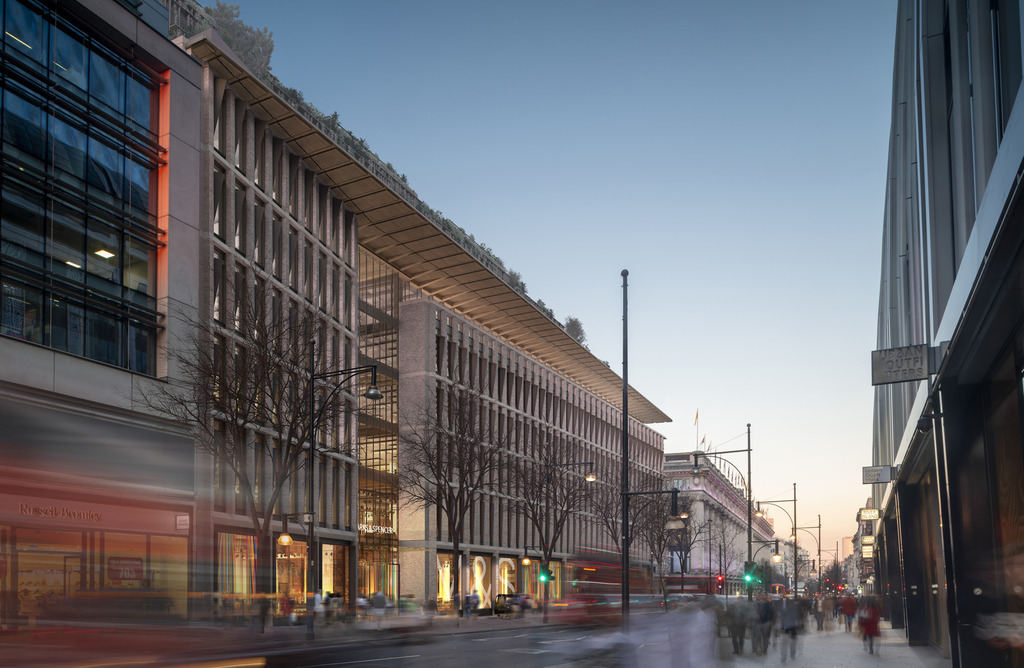
Letter from London
With summer parties in full swing, reasons to be cheerful are nevertheless rather tricky for the world of property, architecture and planning, writes Paul Finch.
As far as London is concerned, we have been waiting for three key public inquiry decisions, endorsed or otherwise by a Secretary of State, Michael Gove, whose own future is a matter for speculation. Will he be moved/promoted/sacked as Prime Minister Rishi Sunak prepares his newish team for the forthcoming general election? There are some who are wishing so, simply because Gove seems so opposed to property and housebuilders.
The inquiry decisions in question? The redevelopment of Marks & Spencer on Oxford Street, the double appeal into alternative tower designs at Borough for Great Portland Estates, and the Mitsubishi redevelopment of the London Weekend Television site on the South Bank. The respective architects, Pilbrow, AHMM and Make have been on tenterhooks as much as their clients.
The first result is now in: Mr Gove, entirely predictably, has ignored the views of the local planning authority (Westminster), the Greater London Authority (the Mayor) and his own planning inspector. He has blocked the development in a grandstanding announcement which is as contradictory as it is headline-grabbing.

Proposal for the new flagship M&S store at 458 Oxford Street by Pilbrow & Partners
Oxford Street is a mess. The M&S building is a mess. The new development would last more than a century and would be the most environmentally efficient development on the street. Hey-ho: more evidence that what is supposed to be the greatest city in the world is coming to a grinding halt. Literally as well as metaphorically: Wandsworth Bridge, a key north/south route, is shutting until October for ‘strengthening’. With Hammersmith Bridge still shut to traffic after four years, the increasingly apartheid nature of the capital, with south Londoners discriminated against in terms of roads, bridges and Underground stations, becomes only too apparent. The Mayor, ironically from south London himself, seems incapable of doing anything about it. What exactly is the point of the Mayor, one begins to wonder!
Meanwhile the developer/investor community is grappling with the implications of slashed asset valuations, plus scant sign of a truly vibrant office market enjoying a wholehearted return to work. On a recent visit to City of London offices as part of a judging panel, I was struck by the minimal number of people at work – and this was on a Wednesday, not the Zombie world of Monday or Friday.
There is an argument which says that average occupancy rates were only ever 65 per cent maximum, and that current rates, at 35 to 45 per cent, are therefore not as bad as one might have expected. Transport for London reports that fare income is back at almost pre-pandemic levels. But are people going to work or to play? Anecdotally, many employers are seriously reducing the amount of workspace they are prepared to pay rent for, and are happy to accommodate the desire of many office staff to work from home at least one day a week, and preferably two or even more. This is because staff retention is considered a smart strategy rather than insisting on office attendance and the risk of people leaving.
This is not true of architects’ offices, where there is greater pressure on people to turn up and contribute to office culture, team working and the creative interaction which is extremely difficult to replicate online. But it seems to be true for more conventional office users – take, for example, HSBC’s departure from Canary Wharf to much smaller space in the City of London. Things may change: the downturn in the economy, plus continuing inflation, means redundancies are already taking place in architect offices, antennae for the economy as a whole. When this happens, people begin to think it may be a good idea for their bosses to actually see them working in the office. It is less stressful to dump the invisible.
Architects are currently nervous on several counts. Firstly, many clients are having second thoughts about whether to proceed with significant projects, particularly office developments which have yet to start or which are still in planning. The risk/reward ratio is increasingly under scrutiny. Secondly, there is a problem with housing development as a result of increasing pressure for second staircases (though not a legal requirement), and the reluctance of investors to take on projects without them because of potential reputational damage if something happened to a one-staircase development.
The Mayor of London could do something about this, by simply announcing that where a second stair is incorporated, any lost apartments will be compensated by an automatic planning permission for an increase in height, enabling their replacement. This might unlock some of the estimated 100,000 units currently on hold.
There is also an underlying feeling that government is anti-development and anti-architects. A recent legal challenge mounted by Berkeley Homes against a decision by Michael Gove to block a rural housing development is a case in point. Amongst other things, Gove criticised the designs as being ‘generic’. You have to wonder whether he thought about this or just blurted it out. Does he think, for example, that Georgian London is an example of generic architecture? Of course. But if so, does he think it was all a terrible mistake? Of course not.
Things are strange when a Conservative government appears to be opposed to housebuilding, while Labour trumpets its support for it (without any credible indication of how it would go about generating it).
Perhaps it is all a result of a belief that building is bad because, as we are frequently and monotonously told, construction is responsible for the oddly round figure of 40 per cent of carbon emission, alternatively that it is a suspiciously precise figure of 42 per cent. Or 38 per cent.
All nonsense, since most of the carbon emissions over the lifetime of a building are the result of the economic activities taking place within them. Let’s hope those activities last for at least a bit longer.
Founder Partner






